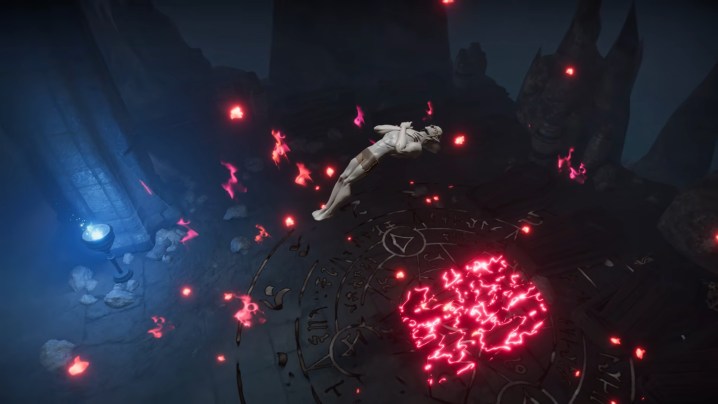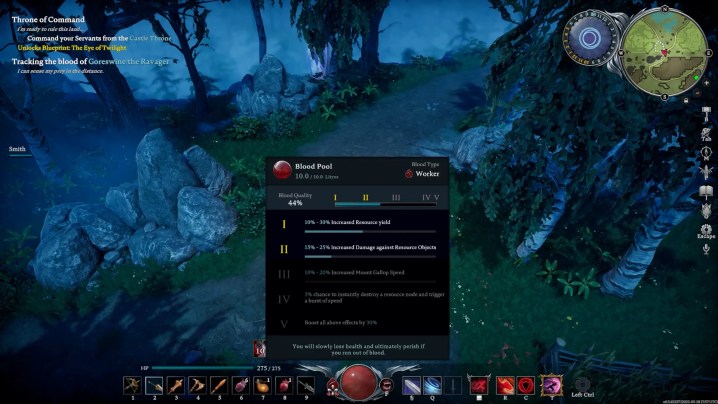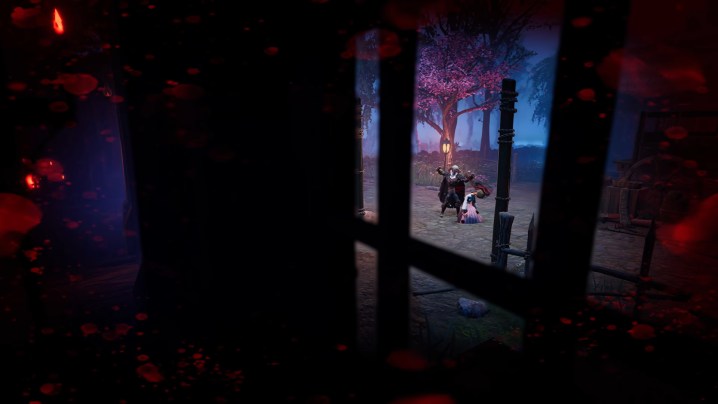
V Rising had little hype before it came out in 2022, but quickly become one of the year’s breakout hits on PC. Combining elements of the survival genre, action RPGs, and wrapping it all up in a gothic vampire tale has resulted in an incredibly deep and addicting game that is sure to suck hours of your life away. After creating your own unique vampire, you’re almost immediately let loose in a world that, understandably, wants nothing more than to see you dead. You have a lot of ways to fight back, but that amount of choice, and multiple progression systems you need to balance, would be hard for even an immortal creature of the night to keep track of.
Not only do you have your own vampire’s stats, abilities, gear, and other RPG elements to keep track of but also your own castle to build, upgrade, and advance research in to unlock new tools. That’s not even mentioning the multiplayer elements you can engage with. V Rising proves that, despite what you may have thought, taking over the world of Vardoran won’t be easy. If you want to become the apex predator of the night, here are the most important tips and tricks you need to get started in V Rising.
Choose your game mode carefully

Before you rise from your grave as a new vampire, you must first pick one of the four game modes V Rising offers. These don’t change how the core game works, but will make your experience playing it very different depending on which one you choose. The options you have are: PvE, PvP, Full Loot PvP, and Duo PvP. Here’s how each one works.
- PvE is the one we highly recommend new players start with. V Rising comes built with multiplayer in mind, though this is the only mode you can go to if you do want to play a solo experience. This mode can also allow up to three others to join your world, but without any way for the other players to attack you or your structures. Consider this the standard single-player or co-op mode for V Rising.
- PvP puts you in a server where any other vampires can, but don’t necessarily have to, attack you and your base. You are all moving, building, and expanding in the same world at the same time, so if one player pulls ahead, they can easily come and crush your under-leveled character. When you do die in this mode, everything you had in your inventory will be dropped for your attacker to loot, but you are spared all your equipment and tools.
- Full Loot PvP is the hardcore version of PvP that should be saved until you’ve fully mastered the mechanics of V Rising. It has all the same basic rules of PvP, where all players are free to attack one another whenever you wish, but instead of just losing your inventory on death, you lose everything your character had up to that point, making it an incredibly high-risk, high-reward mode.
- PvP Duo is the middle ground between PvP and Full Loot PvP. As you might guess, this mode gives you one dedicated ally to team up with against another team of vampires. This can be a fun mode to dip into once you and a friend have gotten your feet wet working together in PvE and want to put your teamwork to the test against more intelligent, and deadly, opponents.
Focus on the Journal Quests first

Journal Quests are kind of like your tutorial missions in V Rising. Technically, you don’t have to do any of them and can just go off on your own, but doing so would seriously cripple your progression. Before you even think about branching off and doing your own thing, finish up all these Journal Quests first since they not only teach you about all the basic mechanics you need to know in V Rising but also unlock the ability to do certain things. You won’t know it until you complete them, but some Journal Quests actually hold back your progression and ability to do certain important mechanics until you work your way through them.
Blood, steel, and magic
As a vampire, you need blood to survive. Of course, not many creatures out there are going to simply give you their blood without putting up a fight. Blood, combat, and your vampiric abilities are all very in-depth mechanics that, while tutorialized, are still a little odd to wrap your head around.
Blood types

No, we’re not talking about A, B, or O here. In V Rising, different things you suck blood from all have a different type and quality that determine what buff you get from that blood. While you won’t always have a choice in the matter if you’re running low, which can eventually lead to your death, you should always look to get the best, highest-quality blood there is. You can only have one blood type buff active at once, and sucking a different blood type will replace whatever one you currently have, although you do get every tier of that blood type’s buffs at and below the quality level you get it at, maxing out at 5. Here are all the different types and the buffs they give you.
- Creature:
- Level 1 quality gives you between a 3% and 15% movement speed increase
- Level 2 gives you a 10-25 increase to your Sun Resistance rating
- Level 3 is a flat 10-20% damage reduction buff
- Level 4 gives you 150% boost to your health regeneration
- Level 5 increases all previous bonuses by 30%
- Brute
- Level 1 makes your main attack get between 7.5-12.5% Life Leech
- Level 2 increases your primary attack speed by 7.5-12.5%, plus increases your Gear Level by 1
- Level 3 buffs any healing you receive by 20-30% and heals you for 4% of an enemy’s total health when you land a killing blow
- Level 4 gives you a 6% chance per relative health recovered to get a movement speed buff of 20% and 25% damage increase on your main attack
- Level 5 increases all previous bonuses by 30%
- Rogue
- Level 1 buffs your crit chance by 10-20% with Weapon Attacks
- Level 2 is a straight up 8-15% increase to movement speed
- Level 3 makes your Travel skills have a 12-25% faster cooldown and 100% chance to land a crit on the attack immediately following a Travel Skill
- Level 4 makes every crit have a 50% chance of exposing the enemy’s armor, which increases all damage they receive by 15% for 4 seconds.
- Level 5 increases all previous bonuses by 30%
- Warrior
- Level 1 buffs your Physical Power by 10-20%
- Level 2 reduces your Weapon Skill cooldown by 8-15%
- Level 3 reduces the damage you take by 7.5-15% and increases damage dealt by 25% if you have full health
- Level 4 gives you a 15% chance to automatically parry any attack, which reduces damage taken by 50%, as well as buffs your own damage by 25%
- Level 5 increases all previous bonuses by 30%
- Worker
- Level 1 increases the amount of resources you get by 10-30%
- Level 2 makes you deal 15-25% more damage against Resource Objects
- Level 3 increases your speed while on horseback by 10-20%
- Level 4 gives you a 3% chance to instantly break a resource node and gain a speed boost
- Level 5 increases all previous bonuses by 30%
- Scholar
- Level 1 buffs your spell power by 12-25%
- Level 2 reduces your spell cooldown by 8-15%
- Level 3 gives your spells 5-10% Life Leech
- Level 4 gives you a 20% chance to reset a spell’s cooldown on cast
- Level 5 Increases all previous bonuses by 30%
Combat
V Rising is an isometric-style game, but more in the Diablo sense than a more tactical RPG in that it’s all happening in real time and heavily reliant on skill shots and positioning. You can equip one of five different weapon types that you can make in the early game, with a few higher-quality ones unlocking as you get new recipes and blueprints. The five early game types are:
- Swords
- Dual Axes
- Maces
- Spears
- Crossbows
Each of these fit into a basic archetype, with swords being balanced, dual axes focusing on chop damage and cutting wood, maces being heavy but high damage, spears having longer range, and crossbows obviously being your fully ranged option. Each weapon also can get three specific Weapon Techniques you will unlock as you upgrade your gear. Play around with the early, cheaper weapons and then invest the more rare materials to upgrade the one you feel suits your vampire best.
Magic and vampire abilities
Without getting too deep into the intricacies of these, you will want to get to know both your magic and vampire abilities well. Magic abilities are your standard elemental attacks and such, though they do get more varied as you level up. However, your hot bar can only hold one Travel Ability, two Basic Abilities, and one Ultimate Ability, so choose wisely what you want to be casting.
Vampire abilities are far less in number, 10 in total, and can only be earned by completing quests or beating special bosses. These are powerful abilities, but require you to be stationary when using them, plus have a long casting time, making them hard to use in a pinch. They’re best used in preparation of a fight, since they tend to be more buff-oriented than directly offensive.
Stay in the shadows

You’re a vampire, so exposing yourself to the sun’s rays is a surefire way to, well, catch on fire. Not literally, exactly, but if the sun’s rays hit your character for too long, you will start to take tons of damage until you either get into cover or die. Stalking the world at night is the obvious way to avoid the sun’s menacing rays, but shadows also do the trick. It does make traversal much more difficult, having to spring from shadow to shadow, but it is possible. Be aware that the sun does move over time, meaning a shadowy space one moment could be exposed a few moments later. Stick to your castle during the day, and always keep an eye on the clock when out at night to not get caught too far from shelter when dawn breaks.
Ensnare servants

What kind of vampire doesn’t have a host of servants? V Rising lets you have only nine servants per castle, but that’s more than enough for how useful they can be. Not only can they fight for you but you can even send them on hunts, gather resources, or just be a handy supply of blood for when you get hungry. There’s a lot to this system, so don’t shrug off recruiting some mortal slaves.



